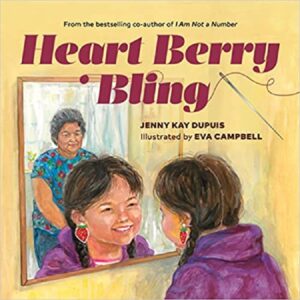HighWater Press celebrates 15 years of publishing Indigenous pedagogy

By Kelly Anne Smith
WINNIPEG — Many of Canada’s celebrated Indigenous storytellers have been published by HighWater Press, such as Jenny Kay Dupuis of Nipissing First Nation with her 2023 Heart Berry Bling.
An imprint of Portage & Main Press, HighWater Press is a leading publisher of Indigenous fiction, nonfiction, children’s titles and graphic novels.
As HighWater Press celebrates its 15th anniversary in August, publisher Catherine Gerbasi talks of the press helping to teach history that was omitted in schools.
“Portage and Main Press is an educational publisher and we also publish books for teachers. And many of our books for teachers are by Indigenous educators. So, we also publish works of Indigenous pedagogy,” Gerbasi explains. “Because of that connection [with] the education market, HighWater Press books fit really well into schools and libraries because of our background as publishers in the educational field but also that symbiotic connection between the work we’re doing and many of the up-and-coming Indigenous educators as well.”
Gerbasi says there have been important issues addressed over the 15 years that Highwater Press has been a press.
“The issues, the trauma, that the truth and reconciliation commission brought to light for all Canadians in 2015. But prior to that, we published the work In Search of April Raintree by Beatrice Mosionier. She was talking about the Sixties Scoop, the foster care system, institutional racism,” Gerbasi states. “We published the work of David A. Robertson, Seven Generations, that told the history [of] Swampy Creek, his First Nation, and the ensuing violence against those people and talked about the Residential School System in that story.”
Gerbasi says that was prior to the Truth and Reconciliation Commission but when the Truth and Reconciliation Commission report was released, the business exploded.
“It demanded that non-Indigenous people pay attention to the history of First Nations, Métis, and Inuit in Canada.”
Gerbasi sees it as a huge responsibility being a press, perhaps she says, even as a non-Indigenous press.
“We are always listening. Our listening skills have improved because we are careful not to change the stories. They are told in the way the creators want to tell those stories,” Gerbasi notes. “I think of the impact of books that we’ve published such as Indigenous Rights, and When We Were Alone – those were published in 2016. And then This Place in 2019. That was published as a counter story to the 150th Canada celebrations. They have contributed to our culture and are changing that institutional thinking in profound ways. They’ve been embraced by the general public, librarians, lawyers, and are taught in our schools and higher education across North America.”
Gerbasi says HighWater Press also has the responsibility of ensuring books like the classic In Search of April Raintree by Beatrice Mosionier remains in circulation forever.
“It’s a literary work but it’s also an historical document. We also take that role in a way of archivists of the stories that are being told at this time really seriously.”
Gerbasi boosts her books as activism – reading as resistance as a way to change the present and the future.
“I think that reading as resistance means that as a non-Indigenous person, buying a book by an Indigenous writer or an Indigenous illustrator, reading that book, and passing that book along, number one, it gives you a broader perspective. Many of our books actually have the power to change a preconceived notion of what being Indigenous means. It counteracts the effects of racism and bias and colonialism.”
Gerbasi says for the 15th anniversary, HighWater Press presents 15 titles published over the past 15 years.
“That’s what we are celebrating,” she says. “Speaking truth to power – those are the books that we felt best illustrated that pushing back against racism, preconceived notions. Manitowapow, which is a first collection of Indigenous writings in Manitoba ever. It’s a beautiful collection. It shows that storytelling has always happened here from a millennia ago. And it’s just growing. The powers of colonialism could not shut down those stories and the passing down of those stories and what those stories meant which includes language and culture and teachings and knowledge and scientific knowledge, architecture. And those have been passed down.”
In retelling history, Gerbasi thinks the graphic novels This Place, A Girl Called Echo, and 7 Generations really show the other side of the stories that we were never taught.
“That’s why these texts are so important to teachers and librarians because they don’t exist in history books. In the education world, text books aren’t a big thing anymore,” says Gerbasi. “It’s so gratifying to see that graphic novels can be used and are used in the classroom to teach history – history told from an Indigenous perspective.”
Gerbasi points out the many writers living on Treaty 1 territory.
“That’s where many of our writers live and work, like Beatrice Mosionier, David Robertson, Niigaan Sinclair, Warren Cariou, Tasha Spillet, Katherena Vermette, Micheal Redhead Champagne. It’s a really exciting, incredibly creative place to be living and working in this area.”
Gerbasi is intent on an objective she has for HighWater Press in coming times.
“I am working toward at some point in the future handing off HighWater Press to an Indigenous publisher. That is my goal,” she shares. “When you pose the question, where is HighWater Press headed in the future? That is definitely one of my goals, to see it in the hands of an Indigenous publisher and broadening the field of publishing professionals that include those at the top, you know, the publishers.”


